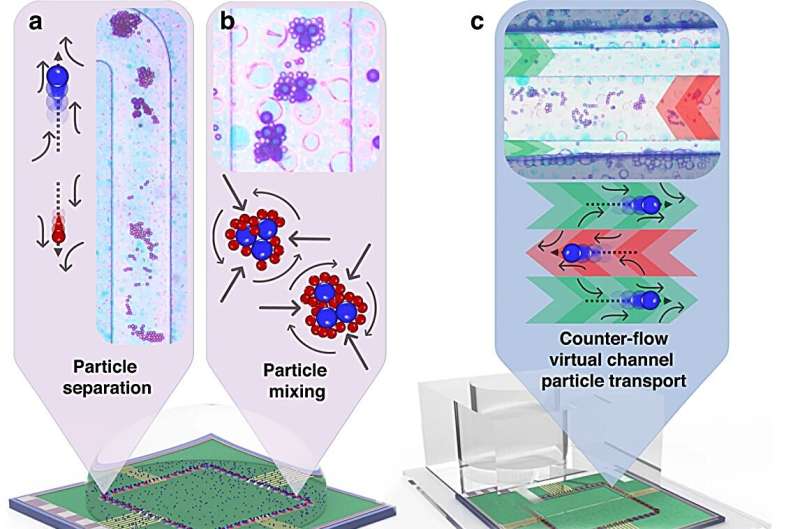Advanced acoustic flow control on the MAWA platform. Credit: Microsystems and Nanoengineering (2024). DOI: 10.1038/s41378-023-00643-8
Acoustofluidics elegantly blends acoustics with fluid mechanics to enable the precise manipulation of fluids and particles at micron and nanoscales. This interdisciplinary field plays a vital role in biomedicine, tissue engineering, and nanoparticle synthesis. However, the effectiveness and potential of traditional acoustofluidic devices are often limited by their reliance on specific geometries of the fluid chamber, thus limiting their adaptability and versatility.
To address these limitations, Membrane Acoustic Wave Actuator (MAWA) technology utilizes guided bending waves (GFW) for efficient, flexible particle control that operates independently of the resonant properties of the chamber due to the evanescent properties of the GFW-driven acoustic field. .
The method is detailed in a study published in Microsystems and Nanoengineering March 8, 2024.
Unlike traditional approaches that rely heavily on the specific design of a microfluidic chamber, MAWA harnesses sound waves by directing vibrations along a micron-thin micromachined membrane that acts as an acoustic waveguide, without being restricted by the surrounding geometry.
This innovation allows scientists to precisely control the movement of particles on top of the membrane, whether mixing, separating or transporting them within any fluid space on the microchip.
The study delves into the mechanisms that guide how these sound waves interact with particles in fluids, providing a glimpse into a future where lab-on-a-chip devices are more versatile and powerful than ever before.
Experiments have shown that by adjusting the frequency and phase of these sound waves, particles can be mixed within the confines of tiny droplets or microchannels, separated by size, and even moved against the flow of a fluid.
First author Dr. Philippe Vachon said: “Our research on microfluidics has made significant progress in particle manipulation capabilities through localized acoustofluidic effects. This method based on cavity-agnostic guided bending waves provides a new platform for microfluidics. It opens up new avenues for the design and application of control technology.
More information:
Philippe Vachon et al., Transmembrane acoustic waves induce guided bending waves on actuators for chamber-independent acoustofluidic manipulation, Microsystems and Nanoengineering (2024). DOI: 10.1038/s41378-023-00643-8
citation: Pushing the boundaries of microlabs: New technology using sound waves has implications for nanoparticle manipulation (2024, April 23), Retrieved April 24, 2024, from https://phys.org/news/2024- 04 -boundaries-tiny-labs-technology-impact.html
This document is protected by copyright. No part may be reproduced without written permission except in the interests of fair dealing for private study or research purposes. Content is for reference only.
#Breaking #boundaries #microlabs #technology #sound #waves #implications #nanoparticle #manipulation
Image Source : phys.org
